Flood-Resistant Innovation: Lida Group’s Temporary Container Buildings Feature Elevated Prefab Construction for Coastal Emergency Housing
2025-Jul-30 09:38:44
By Admin
1. Introduction
Coastal regions around the world are highly vulnerable to floods, which can be triggered by tropical storms, hurricanes, storm surges, and heavy rainfall. These floods often result in the destruction of homes, displacement of residents, and disruption of essential services. In the aftermath of such disasters, the need for safe, temporary emergency housing becomes urgent. Traditional emergency housing solutions, however, often struggle to withstand the challenges posed by coastal floods, either due to their low-lying construction or lack of durability.
Lida Group, a pioneer in prefabricated construction with decades of experience, has introduced a groundbreaking solution to address this critical issue. Their temporary container buildings, featuring elevated prefab construction, are specifically designed to serve as flood-resistant coastal emergency housing. This article explores the innovative features, benefits, deployment processes, and real-world applications of these structures, highlighting why they are becoming a game-changer in coastal disaster response.
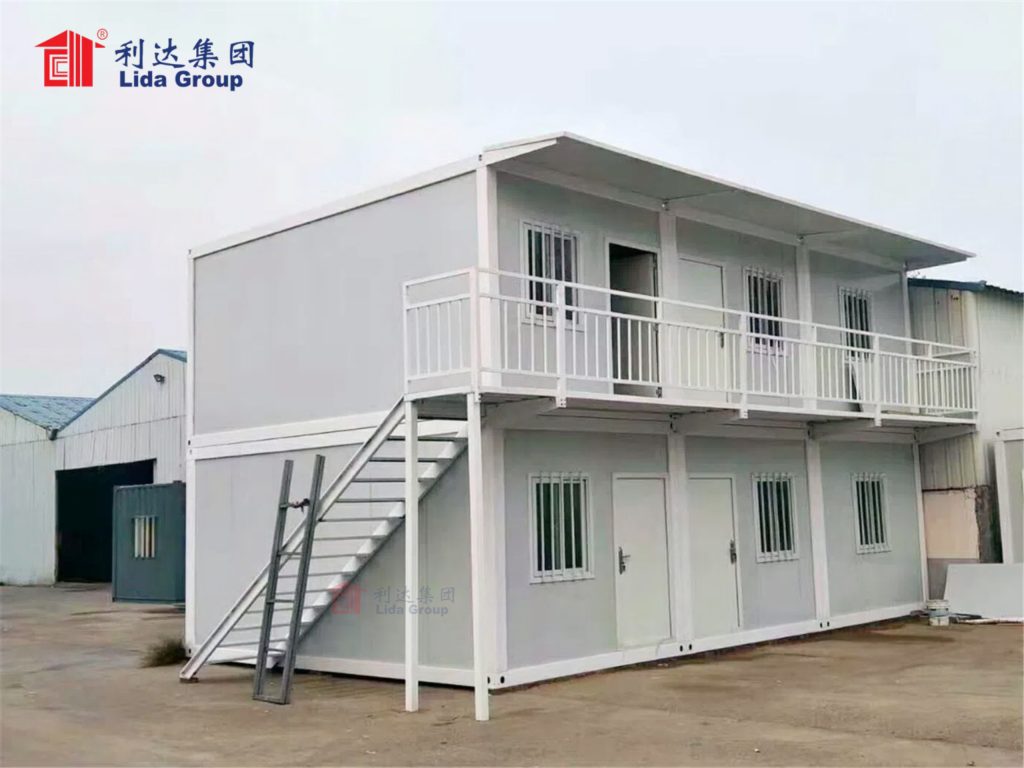
2. The Urgency of Flood-Resistant Coastal Emergency Housing
2.1 The Threat of Coastal Floods
Coastal floods are becoming increasingly frequent and severe due to climate change, rising sea levels, and changing weather patterns. For example, in recent years, coastal areas in Southeast Asia have experienced more intense tropical storms, leading to massive flooding that has destroyed thousands of homes. In the United States, regions along the Gulf Coast and the Eastern Seaboard are regularly at risk of hurricanes and storm surges, which can inundate coastal communities within hours.
These floods not only cause immediate damage to property but also pose significant risks to human life. Residents often have to evacuate at a moment’s notice, and upon returning, they find their homes uninhabitable. The lack of safe temporary housing can force people to live in overcrowded shelters, tents, or even in flood-damaged structures, exposing them to health hazards such as mold, contaminated water, and the spread of diseases.
2.2 Limitations of Traditional Emergency Housing
Traditional emergency housing options, such as tents and prefabricated cabins, have several drawbacks in coastal flood zones. Tents offer minimal protection against water, wind, and extreme temperatures, and they can easily be swept away by strong currents. Prefabricated cabins that are not elevated often end up submerged in floodwaters, leading to structural damage and making them uninhabitable. Even permanent homes in coastal areas are not always designed to withstand frequent floods, as many are built on low-lying land without proper flood mitigation measures.
Moreover, traditional construction methods for temporary housing are often time-consuming, requiring on-site assembly with large teams of workers and heavy equipment. This can delay the provision of housing to those in need, especially in areas where infrastructure has been severely damaged by the flood.

3. Lida Group’s Elevated Prefab Container Construction: Key Innovations
3.1 Elevated Design
The cornerstone of Lida Group’s flood-resistant innovation is the elevated design of their temporary container buildings. Unlike traditional container structures that sit directly on the ground, these buildings are mounted on sturdy steel stilts or pilings. The height of the elevation is carefully determined based on local flood risk assessments, typically ranging from 1.5 to 3 meters above the ground. This ensures that even during moderate to severe floods, the living spaces remain above water level, protecting occupants and their belongings from water damage.
The steel stilts are designed to be corrosion-resistant, a crucial feature in coastal environments where saltwater and high humidity can accelerate rusting. They are also engineered to withstand strong winds, which are common during storms, ensuring the stability of the entire structure.
3.2 Prefabricated Construction
Lida Group’s container buildings are fully prefabricated in controlled factory environments. This means that all components, including walls, roofs, floors, and internal fixtures, are manufactured and assembled off-site before being transported to the coastal disaster area. The prefabrication process ensures high quality and consistency, as each component is built to precise specifications and undergoes rigorous testing.
The use of standardized modules allows for quick and efficient assembly on-site. The container units are designed to be easily connected to each other and to the elevated support structures, reducing the time and labor required for installation. This prefabricated approach also minimizes waste, as materials are measured and cut with precision in the factory, unlike on-site construction where excess materials often end up as debris.
3.3 Durable Materials
To withstand the harsh coastal environment, Lida Group uses high-quality, durable materials in the construction of their container buildings. The main structure is made from heavy-duty steel, which provides exceptional strength and resistance to impact from debris carried by floodwaters. The walls and roofs are insulated with materials that are both water-resistant and fire-retardant, ensuring the safety and comfort of occupants.
The exterior of the containers is coated with a special anti-corrosive paint that protects against saltwater and humidity, extending the lifespan of the buildings even in harsh coastal conditions. Windows and doors are fitted with shatterproof glass and reinforced frames to withstand strong winds and flying debris, further enhancing the safety of the structure.
3.4 Adaptable and Functional Design
Lida Group’s temporary container buildings are designed to be highly adaptable to the needs of coastal communities. They can be configured in various layouts, from single-unit shelters for small families to multi-unit complexes that can accommodate larger groups. Each unit is equipped with essential amenities, including a sleeping area, a small kitchenette, and a bathroom with basic plumbing.
The buildings are also designed to be connected to temporary utility systems, such as portable generators for electricity, water tanks with filtration systems, and septic tanks for waste management. This self-sufficiency is crucial in coastal areas where infrastructure may be damaged or non-existent in the aftermath of a flood.
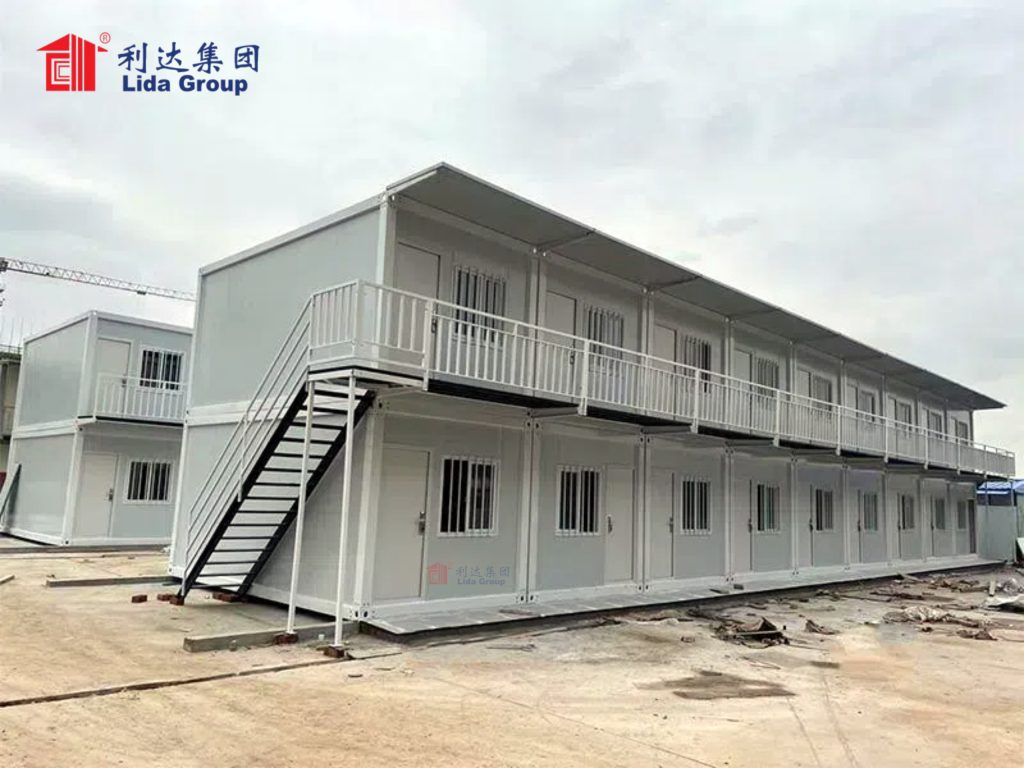
4. Benefits of Lida Group’s Flood-Resistant Container Buildings
4.1 Enhanced Safety
The primary benefit of these elevated container buildings is the enhanced safety they provide to occupants. By being elevated above flood levels, they reduce the risk of drowning and exposure to contaminated floodwaters. The durable construction and reinforced features also protect against wind damage and flying debris, making them a safe haven during storms and floods.
In addition, the use of fire-retardant materials and proper ventilation systems reduces the risk of fire and mold growth, ensuring a healthy living environment for residents. The buildings are also designed to be accessible, with ramps and handrails for individuals with disabilities, ensuring that everyone can find safe shelter.
4.2 Rapid Deployment
One of the most significant advantages of Lida Group’s prefabricated container buildings is their rapid deployment capability. Since all components are pre-manufactured, they can be transported to the disaster area quickly and assembled on-site in a matter of days, rather than weeks or months. This is critical in the aftermath of a flood, where the need for housing is immediate.
The standardized design and modular construction allow for a streamlined installation process. A small team of trained workers can assemble a single unit in just a few hours, and larger complexes can be completed within a week. This rapid deployment helps to reduce the time that displaced residents spend in overcrowded or unsafe shelters.
4.3 Cost-Effectiveness
Compared to traditional construction methods for emergency housing, Lida Group’s container buildings offer significant cost savings. The prefabrication process reduces labor costs, as most of the work is done in the factory rather than on-site. The use of standardized materials and components also lowers material costs, and the modular design allows for easy expansion or downsizing as needed.
Moreover, the durability of the buildings means that they can be reused in multiple disaster events, reducing the need for constant replacement. This reusability makes them a cost-effective long-term solution for coastal regions prone to frequent floods.
4.4 Environmental Sustainability
Lida Group is committed to environmental sustainability, and their container buildings reflect this commitment. The prefabrication process minimizes waste, as materials are used efficiently and excess materials can be recycled. The steel used in the construction is also recyclable, reducing the environmental impact at the end of the building’s lifespan.
The buildings are designed to be energy-efficient, with insulation that reduces the need for heating and cooling. They can also be equipped with solar panels and rainwater harvesting systems, making them more self-sufficient and reducing reliance on non-renewable energy sources. This focus on sustainability aligns with global efforts to reduce the carbon footprint of construction and disaster response.
4.5 Flexibility and Reusability
The modular design of Lida Group’s container buildings makes them highly flexible. They can be easily relocated to different areas as needed, whether to respond to a new flood event or to support long-term recovery efforts. This flexibility is particularly valuable in coastal regions where the risk of flooding is ongoing, and housing needs can change over time.
The buildings are also designed to be reused multiple times. After a flood event, they can be inspected, repaired if necessary, and stored until they are needed again. This reusability not only reduces costs but also minimizes the environmental impact of producing new emergency housing for each disaster.
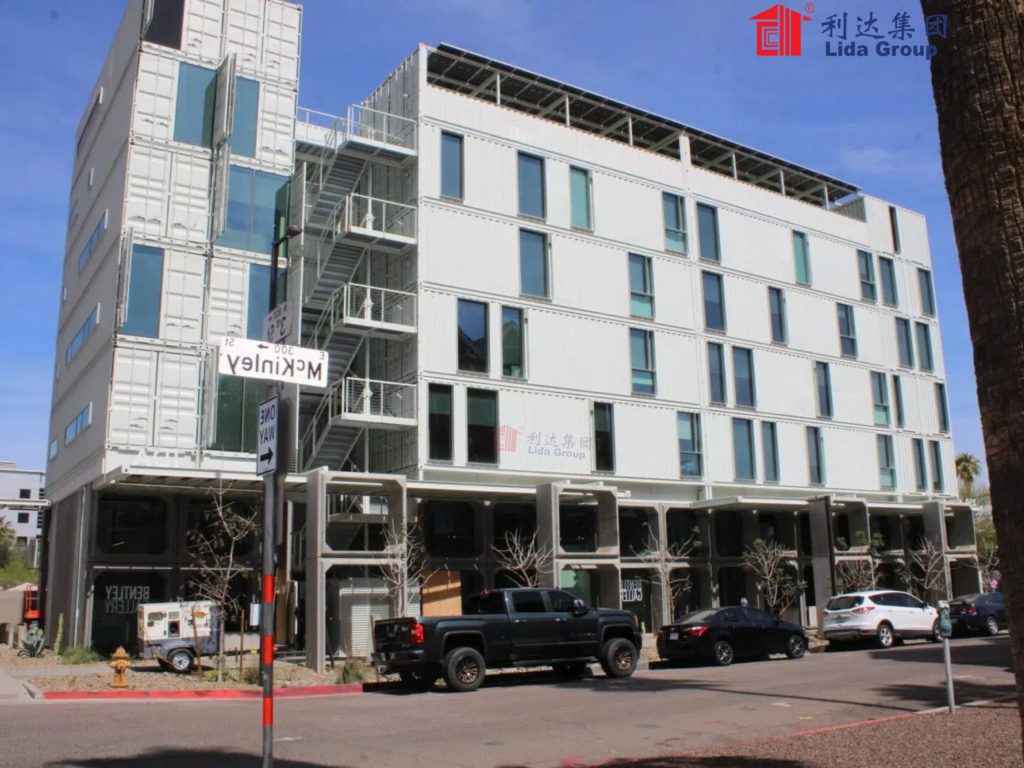
5. Deployment Process of Lida Group’s Container Buildings
5.1 Pre-Disaster Planning and Preparation
Lida Group works closely with local governments, disaster response agencies, and non-profit organizations to develop pre-disaster plans for coastal regions at risk of flooding. This includes conducting flood risk assessments to determine the appropriate elevation for the container buildings in different areas. Based on these assessments, the company maintains a stock of prefabricated components and complete units in strategic locations, ensuring that they can be deployed quickly when a flood occurs.
Training programs are also provided to local emergency response teams, teaching them how to assemble, install, and maintain the container buildings. This ensures that there is a skilled workforce ready to respond to a disaster, reducing reliance on external teams and speeding up the deployment process.
5.2 Post-Disaster Assessment and Mobilization
When a flood occurs, Lida Group’s disaster response team works with local authorities to assess the extent of the damage and determine the housing needs of the affected population. This includes identifying safe locations for the container buildings, ensuring that they are situated on high ground and away from potential hazards such as unstable soil or falling debris.
Once the assessment is complete, the company mobilizes its resources, transporting the prefabricated units and necessary equipment to the disaster area. The transportation is coordinated with local logistics providers to ensure that the units arrive as quickly as possible, even in areas where infrastructure has been damaged.
5.3 On-Site Installation and Setup
On-site installation begins with the preparation of the foundation. The steel stilts or pilings are driven into the ground using specialized equipment, ensuring that they are stable and can support the weight of the container units. The container units are then lifted into place using cranes and secured to the stilts, with connections checked to ensure stability.
Once the structural installation is complete, the internal fixtures and utilities are connected. This includes installing plumbing, electrical systems, and ventilation, as well as setting up temporary water and power sources. The final step is a thorough inspection to ensure that the buildings are safe and functional, with any necessary adjustments made before residents move in.
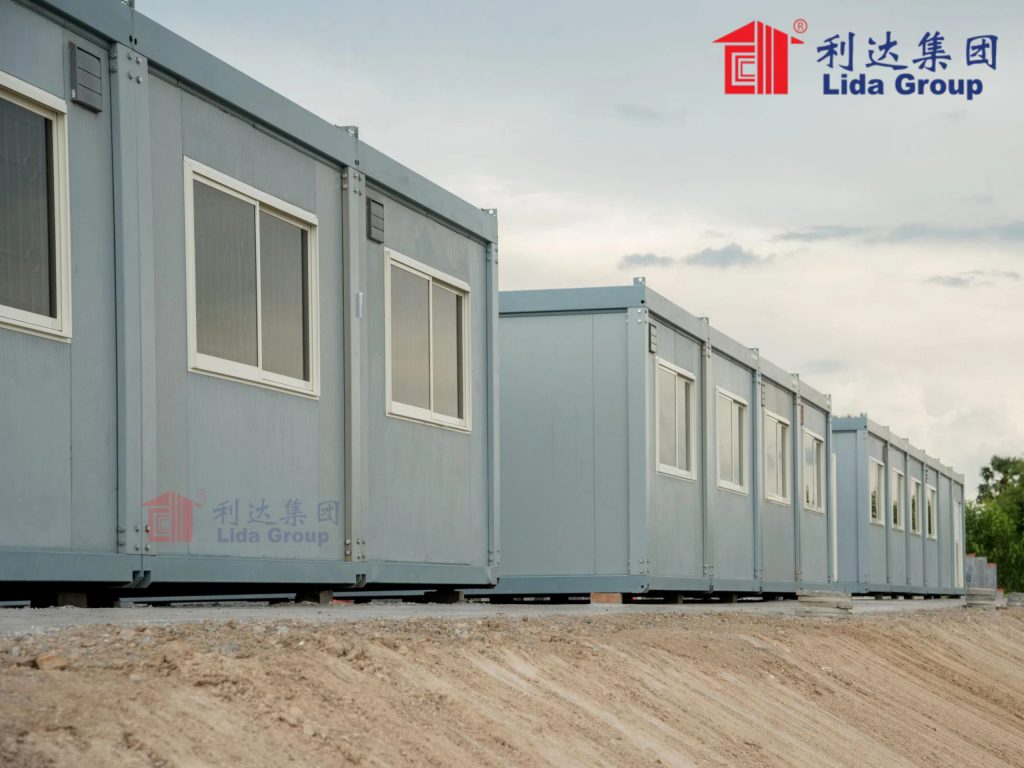
6. Case Studies: Successful Applications in Coastal Flood Zones
6.1 Southeast Asian Coastal Community
In 2023, a severe tropical storm hit a coastal community in Southeast Asia, causing widespread flooding that destroyed over 500 homes. Lida Group was called upon to provide emergency housing, and within 72 hours, 100 of their elevated container buildings were deployed to the area.
The buildings were installed on stilts 2 meters above the ground, ensuring that they remained above the floodwaters. Each unit housed a family of four, with basic amenities such as beds, a small stove, and a bathroom. The residents reported feeling safe and comfortable, even as heavy rains continued in the days following the storm. The buildings remained intact and dry, providing a stable base for the community to begin rebuilding.
6.2 Gulf Coast Region, United States
In the aftermath of a hurricane that caused significant flooding along the Gulf Coast, Lida Group’s container buildings were used to house displaced residents. Over 200 units were deployed in a matter of weeks, forming a temporary village that included communal spaces such as a dining hall and a medical clinic.
The elevated design protected the buildings from the storm surge, and the reinforced structures withstood the strong winds that followed. The self-sufficient utility systems, including solar panels and water filtration, ensured that residents had access to electricity and clean water even when the local infrastructure was down. The temporary village remained in place for six months, providing stable housing while permanent homes were repaired or rebuilt.
7. Comparison with Other Flood-Resistant Housing Solutions
7.1 Traditional Stilt Houses
Traditional stilt houses have been used in coastal regions for centuries, but they have several limitations compared to Lida Group’s container buildings. Traditional stilt houses are often built using local materials such as wood, which can be susceptible to rot and insect damage in humid coastal environments. They also require skilled local craftsmen to build, which can be a challenge in the aftermath of a disaster when labor is scarce.
In contrast, Lida Group’s container buildings are made from durable steel and prefabricated, ensuring consistent quality and durability. They can be assembled quickly by a small team, making them more suitable for emergency response. Additionally, the modular design allows for easy expansion and customization, which is not always possible with traditional stilt houses.
7.2 Inflatable Flood Shelters
Inflatable flood shelters are a newer emergency housing solution, but they are not as practical for long-term use in coastal areas. They are often made from lightweight materials that can be easily damaged by sharp debris in floodwaters, and they provide minimal insulation, making them uncomfortable in extreme temperatures. They also require constant inflation, which can be a challenge in areas with limited power.
Lida Group’s container buildings, on the other hand, are built to last, with durable materials that can withstand harsh conditions. They provide better insulation and protection from the elements, making them suitable for long-term use. They also do not require constant maintenance, making them more reliable in emergency situations.
7.3 Permanent Flood-Resistant Homes
Permanent flood-resistant homes are designed to withstand floods but are expensive and time-consuming to build. They are not suitable for emergency response, as they cannot be deployed quickly in the aftermath of a disaster. Lida Group’s container buildings, while temporary, offer a cost-effective and rapid solution that can be used until permanent homes are available. They can also be reused in future disasters, making them a more sustainable option than permanent homes that may only be needed once.
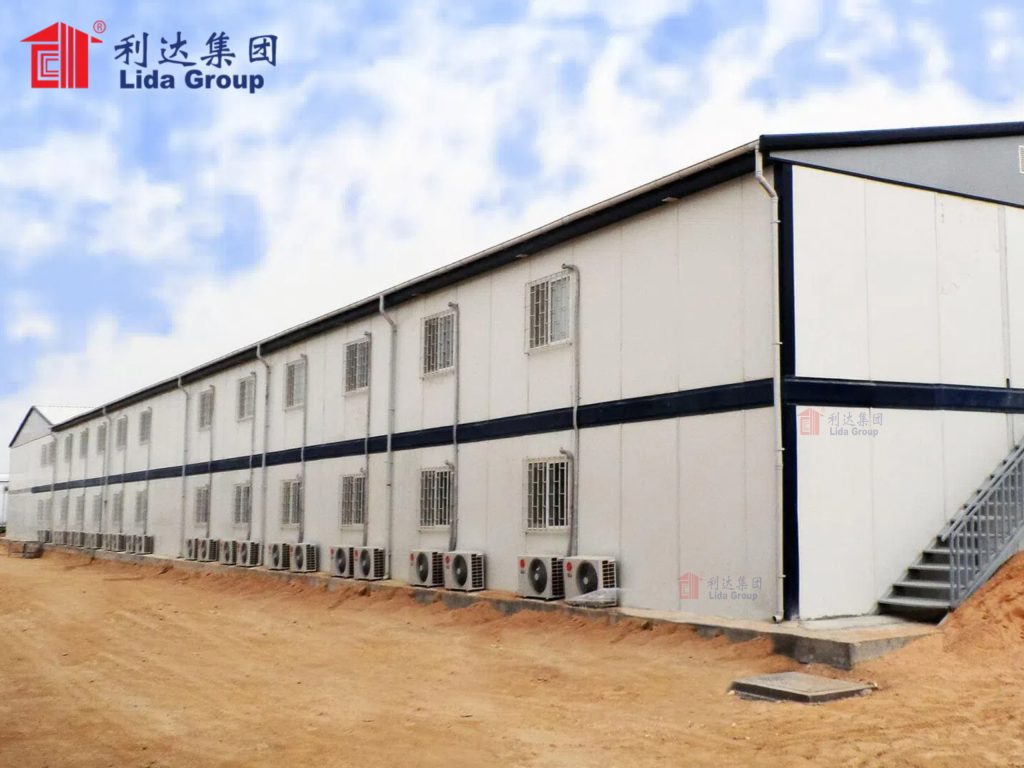
8. Future Developments and Innovations
8.1 Advanced Materials
Lida Group is continuously researching and developing new materials to enhance the performance of their container buildings. This includes exploring the use of composite materials that are lighter, stronger, and more corrosion-resistant than traditional steel. These materials could further reduce the weight of the buildings, making them easier to transport and install, while also increasing their durability in coastal environments.
8.2 Smart Technology Integration
The company is also working on integrating smart technologies into their container buildings. This includes installing sensors that can monitor water levels, wind speeds, and structural integrity in real-time, providing early warnings of potential hazards. Smart home systems could also be added, allowing residents to control lighting, heating, and ventilation remotely, improving comfort and energy efficiency.
8.3 Enhanced Sustainability Features
Lida Group plans to further enhance the sustainability of their container buildings by increasing their reliance on renewable energy sources. This includes integrating larger solar panels, battery storage systems, and even small wind turbines to power the buildings. They are also exploring ways to collect and treat rainwater more efficiently, reducing the need for external water sources.
8.4 Expansion to Other Disaster-Prone Areas
While the focus is currently on coastal flood zones, Lida Group aims to adapt their elevated container buildings for use in other disaster-prone areas, such as regions prone to earthquakes and wildfires. This would involve modifying the design to withstand the specific challenges of these disasters, such as adding earthquake-resistant features or fire-resistant cladding.
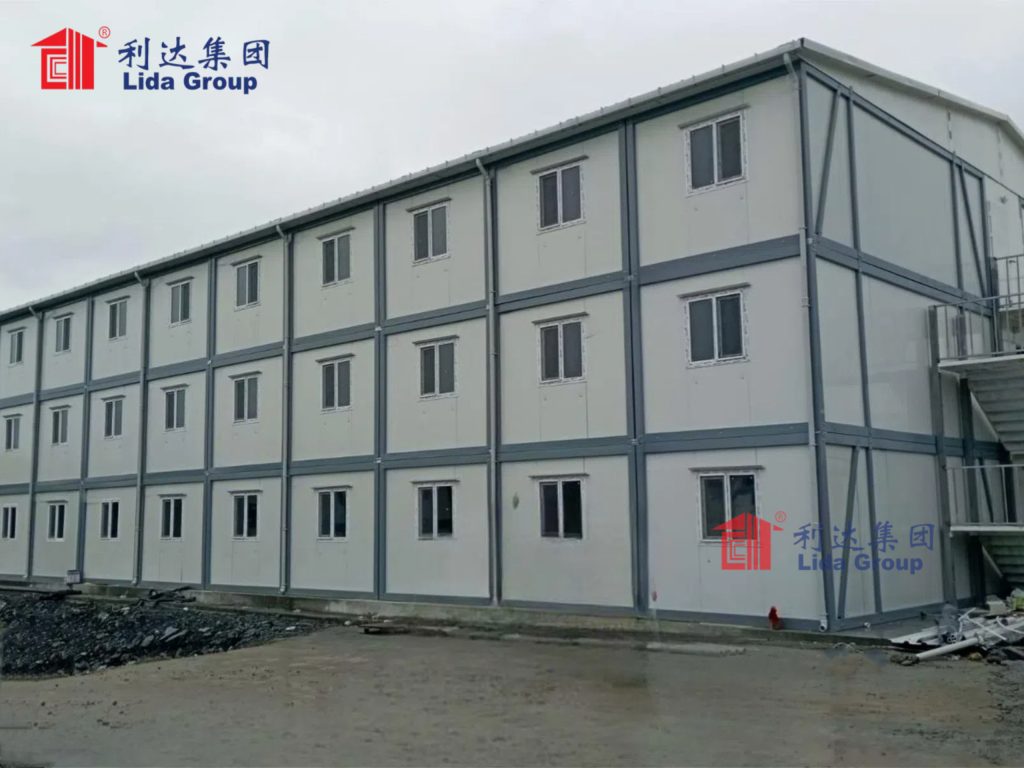
9. Conclusion
Lida Group’s temporary container buildings with elevated prefab construction represent a significant innovation in flood-resistant coastal emergency housing. Their unique design, combining elevation, prefabrication, durability, and adaptability, addresses the critical need for safe, rapid, and cost-effective housing in the aftermath of coastal floods.
The benefits of these buildings, including enhanced safety, rapid deployment, cost-effectiveness, environmental sustainability, and flexibility, make them a superior alternative to traditional emergency housing solutions. Real-world case studies in Southeast Asia and the Gulf Coast have demonstrated their effectiveness in protecting residents and supporting community recovery.
As climate change continues to increase the frequency and severity of coastal floods, the need for such innovative solutions will only grow. Lida Group’s commitment to research and development, including advanced materials, smart technology integration, and enhanced sustainability features, ensures that their container buildings will remain at the forefront of flood-resistant emergency housing.
In conclusion, Lida Group’s flood-resistant container buildings are not just a temporary solution but a vital tool in building resilient coastal communities. By providing safe and reliable housing in times of crisis, they play a crucial role in protecting lives, supporting recovery, and ensuring that coastal regions can bounce back stronger from the impact of floods.
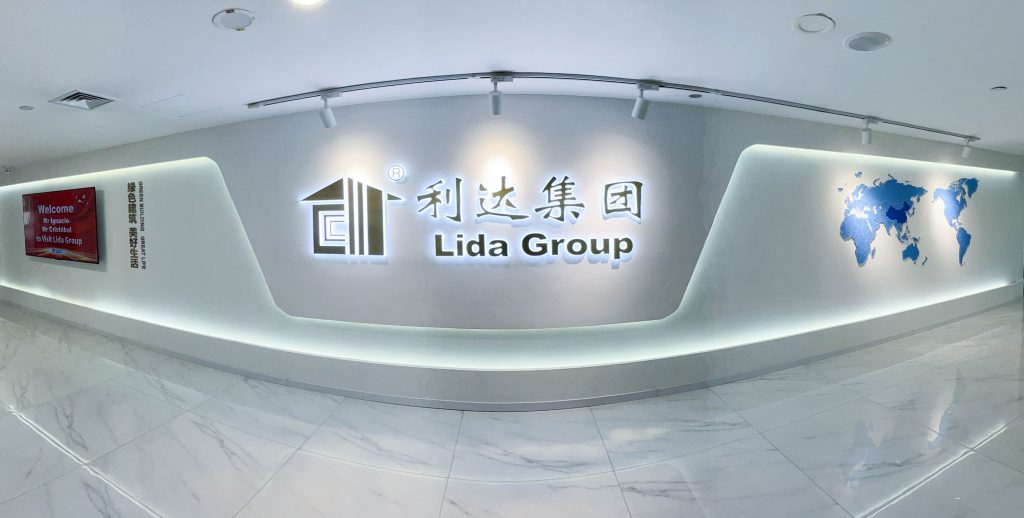
Related news
-
Lida Group Advances Steel Structure Construction with BIM-Driven Designs for High-Quality Steel Warehouse & Farm House Projects
2025-07-29 16:09:05
-
Lida Group Pioneers High Quality Container House Solutions Using Advanced Prefab Container Construction for Global Housing Shortages
2025-07-29 16:31:32
-
Disaster Response Revolution: Temporary Container Buildings Deployed in 72 Hours via Lida Group's Prefab Container Construction Systems
2025-07-29 17:13:58
contact us
- Tel: +86-532-88966982
- Whatsapp: +86-13793209022
- E-mail: sales@lidajituan.com


